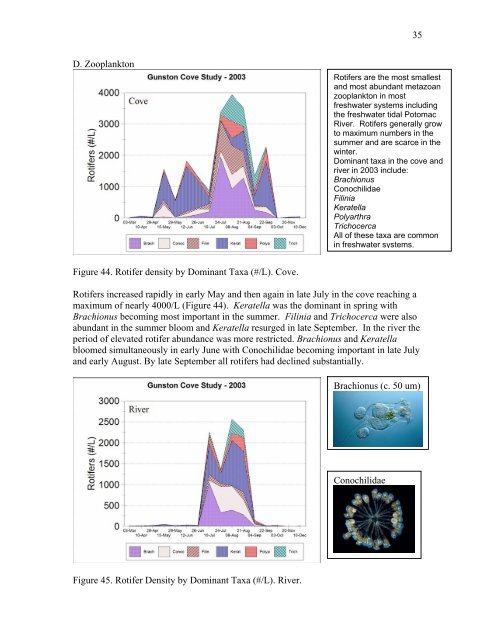NEW: Annual Report - George Mason University
NEW: Annual Report - George Mason University
NEW: Annual Report - George Mason University
You also want an ePaper? Increase the reach of your titles
YUMPU automatically turns print PDFs into web optimized ePapers that Google loves.
D. Zooplankton<br />
Figure 44. Rotifer density by Dominant Taxa (#/L). Cove.<br />
35<br />
Rotifers are the most smallest<br />
and most abundant metazoan<br />
zooplankton in most<br />
freshwater systems including<br />
the freshwater tidal Potomac<br />
River. Rotifers generally grow<br />
to maximum numbers in the<br />
summer and are scarce in the<br />
winter.<br />
Dominant taxa in the cove and<br />
river in 2003 include:<br />
Brachionus<br />
Conochilidae<br />
Filinia<br />
Keratella<br />
Polyarthra<br />
Trichocerca<br />
All of these taxa are common<br />
in freshwater systems.<br />
Rotifers increased rapidly in early May and then again in late July in the cove reaching a<br />
maximum of nearly 4000/L (Figure 44). Keratella was the dominant in spring with<br />
Brachionus becoming most important in the summer. Filinia and Trichocerca were also<br />
abundant in the summer bloom and Keratella resurged in late September. In the river the<br />
period of elevated rotifer abundance was more restricted. Brachionus and Keratella<br />
bloomed simultaneously in early June with Conochilidae becoming important in late July<br />
and early August. By late September all rotifers had declined substantially.<br />
Figure 45. Rotifer Density by Dominant Taxa (#/L). River.<br />
Brachionus (c. 50 um)<br />
Conochilidae
















